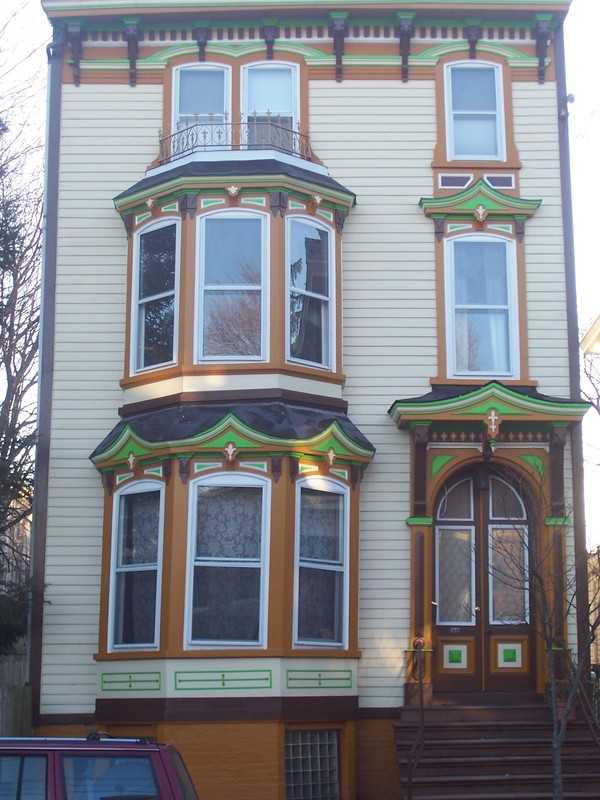William H Johnson House
Introduction
Text-to-speech Audio
Images
William H. Johnson House. (1874). New Brunswick, New Jersey.

Backstory and Context
Text-to-speech Audio
The 1874 William H. Johnson House is exemplary of the mid-nineteenth century High Victorian Italianate style. The home is adorned with elegant detailing that speaks to the prominent social status of the house's first owner, William H. Johnson, a master house painter who owned the property from 1872 until he died in 1904. Viewing the home offers a glimpse into the post-Civil-War era for New Brunswick. The town had transitioned into a manufacturing center, which allowed for a population, economic, and residential-housing boom. Many of the houses outside the urban center, river ports, and train hubs served as homes to non-laborers ranging from those with modest incomes to the wealthy.
The early settlement of New Brunswick by English, Scottish, Scots-Irish, German, French, Dutch, and African slaves began near the Raritan River. New Brunswick benefited from its favorable position on the river between Philadelphia to its south and New York to its north. For much of the nineteenth century, New Brunswick served as a prominent river hub between the two major metropolises during the eighteenth and nineteenth centuries. Construction of the Delaware and Raritan Canal, along with the New Jersey Railroad, took place during the 1830s, further enhancing the town's economic vitality.
By the late nineteenth century, as railroads overtook water traffic as the favored form of transportation and shipping, New Brunswick transitioned from a port city to a manufacturing town; many of the warehouses near the river turned into manufacturing plants. Consequently, the need for workers fostered a population increase and concurrent residential housing boom; the population rose from 11, 287 in 1860 to 15,052 in 1870. Typical of the Gilded Age, workers usually lived close to the factories, railway hubs, and ports, while wealthy owners moved away from the heart of the city.
Though the Johson family did not attain tremendous wealth, they enjoyed a better-than-average income that allowed them to live in a house away from the city center. William H. Johnson, a painter, was born in 1829 in New Jersey and was the son of John Johnson, who also worked as a painter. In the 1860 census, John is listed as a "Master House Painter" who by then lived in New Brunswick and had $6,000 ($185,000 in 2020 values) in real estate value and $2,000 ($60,000 in 2020) in his personal estate. By the end of the Civil War, records show John and William working together as "John Johnson & Son, painters." Their work mainly involved painting houses of those with means, with disposable income.
On June 25, 1836, Abraham Suydam sold the property for which the William H. Johnson house sits to James Lorimer Graham as part of a large tract of farmland, serving as the earliest record of the property. Between 1836 and 1870, the property exchanged hands numerous times. Finally, in 1872, William H. Johnson purchased the property and built the historic home (sometime between 1872-1874). William H. Johnson died at the age of 74 on February 26, 1904, survived by his wife, Sarah, and his three grandsons (the sons of his deceased daughter, Adilade B. Kilpatrick. The house and estate remained in the Johnson family's hands until William's widow sold it in 1906.
Sources
"Glimpse of History: New Brunswick's William H. Johnson House: Historical treasure and home to many." New Jersey Star-Ledger. nj.com
Mar 31, 2019. https://www.nj.com/news/local/2011/07/glimpse_of_history_new_brunswi_2.html
Kafka-Holzschlag, Morris J. and Suzanne L. Gehlert. "New Brunswick and Transportation: A Brief Sketch of the History of Transportation and the Architecture of the Train Station." The Journal of the Rutgers University Libraries. 51 (2012). http://jrul.libraries.rutgers.edu/index.php/jrul/article/download/1684/3124
Zerber, Nancy, Janice Armstrong, and Stephanie Smith. "Nomination Form: William H. Johnson House." National Register of Historic Places. nps.gov. 2007. https://npgallery.nps.gov/GetAsset/3f2c196d-4116-4a05-baef-37406f63410b
By Elizabeth A. Ciccone, photographer and photo owner. Public Domain, https://commons.wikimedia.org/w/index.php?curid=8992002
